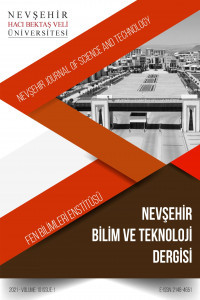Seryum Oksit Katkılı Doğal Obsidyen Camların Mekanik Özellikleri
Doğal obsidyen cam, Seryum oksit (CeO2), Sertlik, Kırılma tokluğu
Mechanical Properties of Natural Obsidian Glasses Doped with Cerium Oxide
Natural obsidian glass, Cerium Oxide (CeO2), Hardness, Fracture toughness,
___
- Morgan L.E., Renne P.R., Taylor R.E. and Gabriel G.W. “Archaeological age constraints from extrusion ages of obsidian: Examples from the Middle Awash, Ethiopia,” Quaternary Geochronology 193-203, 2009
- Bourdonnec F.L., Bontempi J.M., Marini N., Mazet S., Neuville P.F., Poupeau G. and Sicurani J. “SEM-EDS characterization of western Mediterranean obsidians and the Neolithic site of A Furta (Corsica),” Journal of Archaeological Science,37, 92-106, 2010
- Glascock M.D., "Obsidian provenance research in the Americas." Accounts of chemical research, 35(8) 611-617, 2002
- Nazaroff A.J., Prufer K. M., and Drake B. L., “Assessing the applicability of portable X-ray fluorescence spectrometry for obsidian provenance research in the Maya lowlands,” Journal of Archaeological Science, 37 885-895, 2010
- Derkowski, A. "Experimental transformation of volcanic glass from Streda nad Bodrogom (SE Slovakia)." Geologica Carpatica, 53, 2002.
- Negash A., Alene M., Brown F.H., Nash B.P. and Shackley M.S. “Geochemical sources for the terminal Pleistocene/early Holocene obsidian artefacts of the site of Beseka, central Ethiopia,” Journal of Archaeological Science, 34, 1205-1210, 2007
- Smith C. S. "Obsidian use in Wyoming and the concept of curation." Plains Anthropologist, 44(169), 271-291, 1999
- Negash A. and Shackley M.S. “Geochemical Provenance of Obsidian Artefacts from the MSA site of Proc Epic Ethiopia,” Archaeometry, 48, 1-12, 2006
- Abdelounisa H.B., Elleuch K., Vargiolu R., Zahouani H. and Bot A.L. “On the behaviour of obsidian under scratch test,” Wear, 266, 621-626, 2009
- Dorfman B.F. “Obsidian-Natural Nanostructured Glass: Preliminary Research Results”, Proceedings of the XIth International Congress and Exposition, 2008 pp. 1876-1885
- Husien M.S. “Fracture Behavior and Mechanical Characterization of Obsidian: Naturally Occurring Glass” Master Thesis, Oklahoma State University, 2010
- Anstis G.R., Chantikul P., Lawn B.R. & Marshall D.B. “A critical evaluation of indentation techniques for measuring fracture toughness: I, direct crack measurements,” Journal of the American Ceramic Society, 64(9), 533-538, 1981
- Aktas, B., Albaskara, M., Dogru, K., & Yalcin, S., “Mechanical Properties of Soda-Lime-Silica Glasses Doped with Eggshell Powder”, Acta Physica Polonica A, 132(3), 436-438. 2017
- ISSN: 2148-466X
- Yayın Aralığı: Yılda 2 Sayı
- Başlangıç: 2012
- Yayıncı: Nevşehir Hacı Bektaş Veli Üniversitesi
Ali ÇAKMAK, Abdulkadir MALKOÇOĞLU
Batch Reactor Design for Polystyrene Production
Nihayet Koçyigit, Necati Yalçın
Rahile ÖZTÜRK, Esra MALTAŞ ÇAĞIL
AHP ve DEMATEL Yöntemleri İle Nesnelerin İnternetinin İşletmelerde Yapılan Uygulamalarının Analizi
Rumeysa SAÇAK, Şeyda GÜR, Tamer EREN
Sağlık Alanında Kullanılan Biyomateryallerde Biyouyumluluk
Mustafa Burak ÇOBAN, Hülya KARA SUBAŞAT
Rize Kentsel Kıyı Şeridinin Kullanıcı Memnuniyetinin Belirlenmesi
Banu BEKCİ, Merve ÜÇOK, Hasan YILMAZ
Dental Uygulamalarda Kullanılan Biyomalzemeler
Duygu KIRKIK, Barış KARABULUT, Kübra ÖZTÜRK, Sevgi KALKANLI TAŞ
Some Physical Properties of the Building Stones from Elazıg-Nevşehir Region
Seryum Oksit Katkılı Doğal Obsidyen Camların Mekanik Özellikleri
Bülent AKTAŞ, Şerife YALÇIN, Abuzer AÇIKGÖZ, Rahime ŞERBETÇİ
